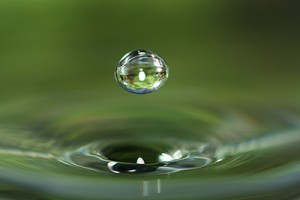Did you know that a seven dollar gadget can reduce both your home water use and your water heating bill by as much as 50%? How many of us know how to make every drop of water that we use count, the way that most people in human history knew how to do because they carried it by hand, and water is bleeping heavy?
Our ancestors had strong backs and mighty careful water habits, and people in the developing world still do. I doubt my back muscles can compare with theirs, but I’ve been practicing water conservation for years, long before the current drought disasters being declared in much of the West.
Here are my household’s water conservation methods, good for both our bank accounts and our environment’s falling water tables. Feel free to add your own water conservation methods under comments.
- We have low-flow showerheads, also known as aerators, which create the same water pressure with sharply less water. They cost just $5-$10 and pay for themselves in a few months with lower energy bills (less hot water used) as well as lower water bills. The Energy Trust of Oregon gave us ours — even installed them — at no cost. Check with your local water and/or power utility for free conservation resources.
- We have no lawn, but rather, plants — vibrant, colorful ones — that need little water. See Top Ten Tips On Xeroscape Gardening. When we used to have a lawn, we let it go brown in the summertime. (OK, I’ll admit that the fact our lawn sported more weeds than grass was one of the motivators to replace it with drought-tolerant plants).
- Our toilets are low-flow, using 1.6 gallons per flush, rather than the 3.5 gallons of water that standard toilets use. While we flush ‘solid waste’ immediately, we let our toilets gather several rounds of liquid waste before flushing. Our low-flow toilets and low-flush habits save at least two thousand gallons of water annually. More info here.
- I take sponge baths rather than showers. While my husband and our guests make good use of our low-flow showerheads, I bathe by rubbing myself all over with a moist washcloth. My skin and body feel great afterward, and air-drying is simpler and more pleasing to me than getting dripping wet, dealing with towels, and then having to squee-gee the shower walls to prevent mildew. While I love an occasional hot bath, especially in winter, I keep the water level in the tub low when I have a bath.
- Our washing machine is Energy Star, using minimal amounts of water as well as energy. It almost seems to splash the clothes it washes, rather than immerse them. They come out at the end clean yet not very wet, needing little drying.
- I leave the water faucet turned off when washing my hands, except to wet them at the beginning, and rinse them at the end. The washing is all about the soap and my energetic hand motions. And the only water I use when brushing my teeth is to rinse the toothbrush at the end. I estimate these habits save more than 500 gallons of water annually (based on conservative assumptions of six hand-washings daily that each save one-quarter gallon).
- We hang and re-wear clothes until they truly need washing, rather than tossing them into the laundry basket just because we’ve worn them. After using washcloths and bath towels, we hang them to dry, using them again and again before we wash them. While underwear gets washed after every use, running socks don’t — rather, I shake them vigorously in the air for half a minute to evaporate the sweat. The fewer loads of laundry we need to do, the less water we use — and the more time we have for fun things like friends, writing, etc.
Most of the Western United States is arid, and always will be. Common sense tells us to live within our water means, just as a household is wise to live within its financial means. Click here for my report on desalination plants, which use enormous amounts of energy to render ocean water drinkable.
photo courtesy of Tanya Puntti



Excellent food for thought, Allison! You’ve made some very good suggestions here.
I’d add one more. While you’re waiting for your hot water to arrive at the kitchen sink, collect the cold. You can fill the coffeemaker, the teapot, the pet’s water dish, the kettle on the woodstove, water the plants, etc. And in the summertime, keep a small pail in the shower to do the same. I used it to water my herb bed.
I read somewhere that undeveloped nations waste just 10% of their water, while we waste so much more. I’m all for conservation!
CLove // Sep 26, 2010 at 6:44 pm
Great info, I have a hard time convincing my DH that my efforts at water conservation is worth it as we live in the Pacific NW where water is abundant. I don’t think we could possibly catch all of our run off, but I’d love an indoor gray water system.
Deb — Great pointer. Thanks.
CLove — yes . . . . sometimes things seem abundant when their source is actually quite finite. For instance, we had little snow in the Cascade Range this past winter, which has meant low flow in the Columbia River and hence a much lower supply of hydroelectricity in Oregon than usual.
A gray water system sounds good . . .. . I’d like to get rain barrels, myself
I would add to this wonderful list with an item related to Deb’s suggestion:
> Keep a large plastic bowl on the left side of the kitchen sink to gather your dish-washing water, then use it to water your potted plants!